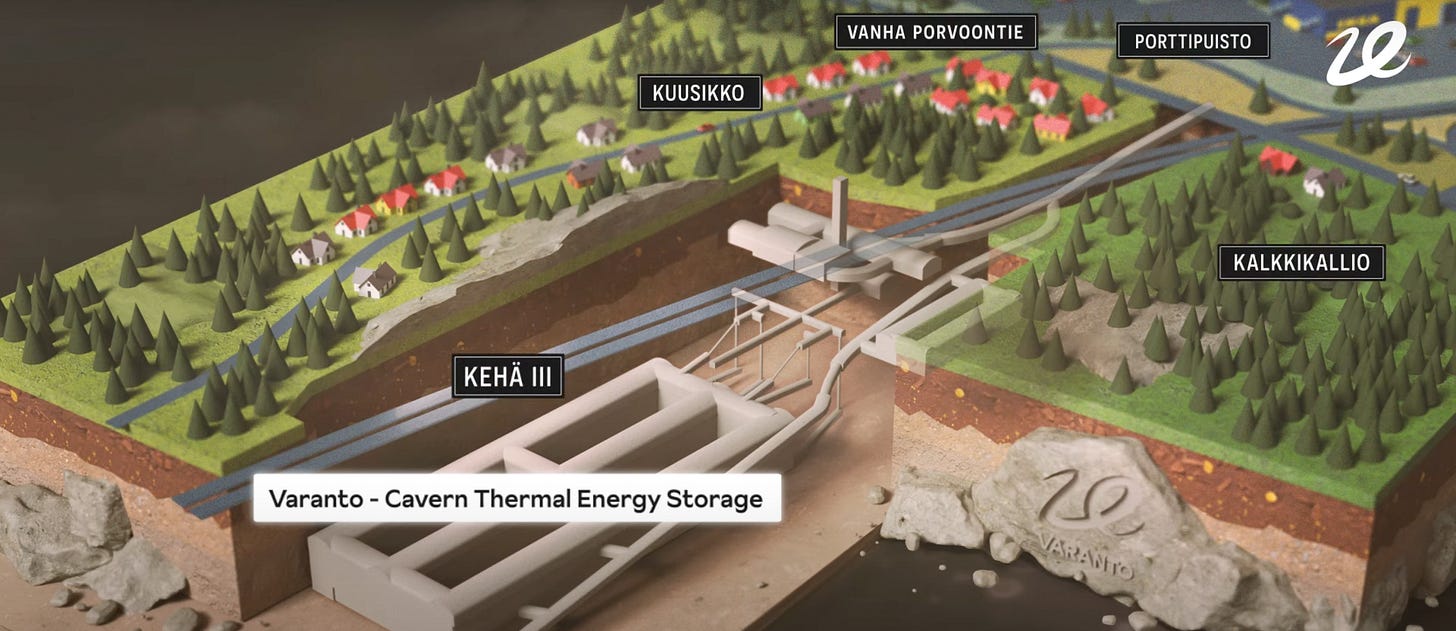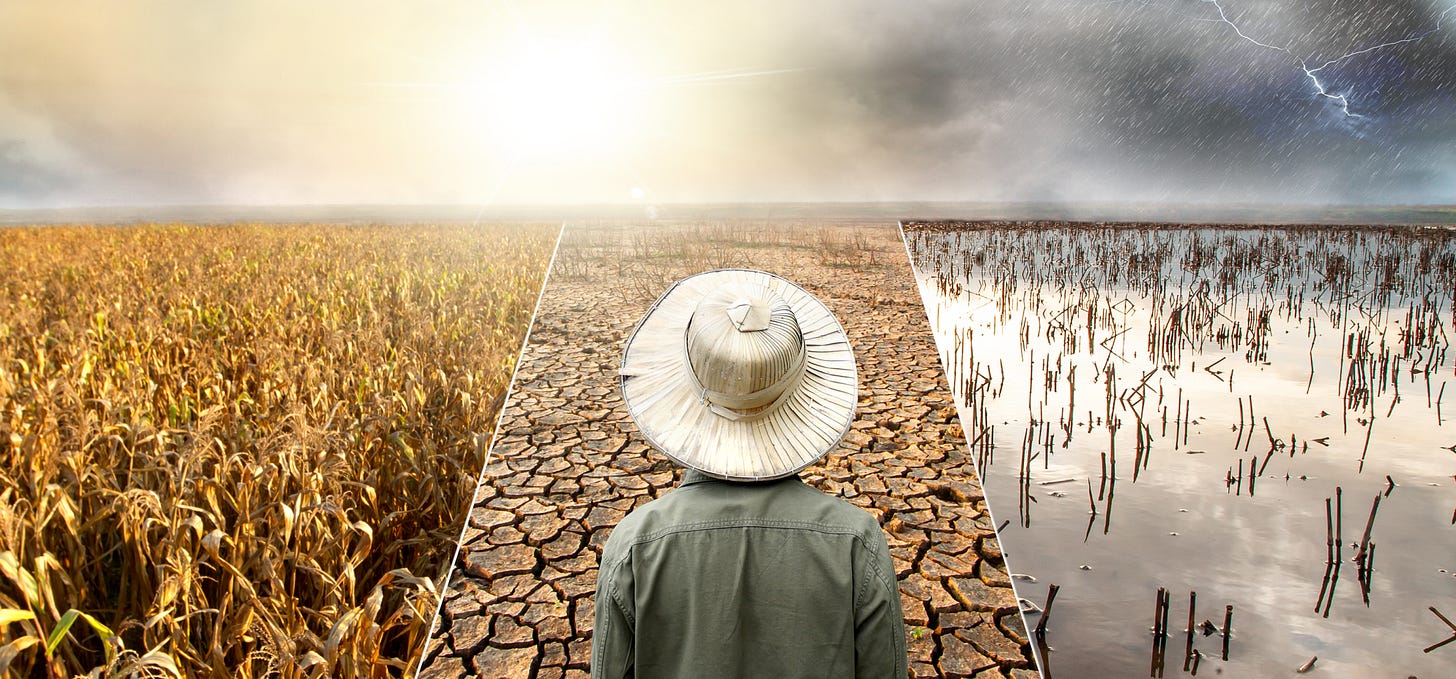Lessons from Finland
Finnish climate action, a year of climate extremes, and a New Year’s challenge
GOOD NEWS
Finland is fast becoming a global climate leader. You might remember a while back I wrote about the world’s largest sand battery in the town of Pornainen, that can store up to 100 megawatts of energy for months. Now, the world's largest underground thermal energy storage facility is being constructed in Vantaa, in caverns carved out of the bedrock. The energy stored there will be enough to "meet the heating demands of a medium-sized city for up to a year," says New Atlas.
Data centers worldwide consume vast amounts of energy and water. But a sustainable, renewably-powered data center is being built in the Finnish town of Mäntsälä that will use its waste heat to warm the local community. And to accelerate Finland’s green transition, Nordea, a Finnish financial services provider, is offering sustainability loans totaling up to 437 million euros to small and medium-sized businesses in the country.
The Finnish Food Authority is even incorporating climate-friendly suggestions into a new set of national dietary guidelines, dropping the amount of recommended red meat to 350 grams per week from 500 grams. "Ultimately, how one eats is a personal choice, but it is good to be aware that a more plant-based diet not only reduces health risks but also mitigates the effects of climate change," said Juha-Matti Katajajuuri, a researcher at the Natural Resources Institute Finland.
Knowledge is power, and in a recent study Finns ranked first in the European Union on their understanding of climate change and the ways to address it. Aarne Granlund, a Finnish climate activist who moved to the region of North Karelia to work on emission reductions there, tells me that one of the biggest things that can make a difference is getting municipal politicians interested—and that’s already happening. Across Finland, municipal emissions of heat-trapping gases have dropped 38 percent from their peak in 2006.
Aren’t these great examples for the world to learn from?
NOT-SO-GOOD NEWS
2024 is set to become another “hottest year on record,” beating out the existing record just set in 2023 and making it the tenth hottest year on record in the past ten years. And 2025 isn’t expected to be any different. As you know, a warmer world means weirder weather. From floods in Nigeria to droughts in the Amazon and many more, 2024 was a year of weather extremes.
What else hit a record high last year? Heat-trapping gas emissions from burning fossil fuels, that’s what. These twin records are no coincidence: nearly three-quarters of the earth’s observed warming is the direct result of burning coal, gas and oil. (The remainder comes from deforestation and agriculture.)
This report from World Weather Attribution puts it bluntly, "This exceptional year of extreme weather shows how dangerous life has already become with 1.3°C of human-induced warming, and highlights the urgency of moving away from planet-heating fossil fuels as quickly as possible."
“In 2025, countries must put the world on a safer path by dramatically slashing emissions and supporting the transition to a renewable future. It is essential — and it is possible,” said UN Secretary-General Antonio Guterres last week. And the science is clear: every bit of warming we prevent will make a difference.
WHAT YOU CAN DO
Every year, I adopt two new climate-friendly habits. Sometimes I go big: two years ago, for example, I decided to try going car-free (and I still am!), and we signed up for wind energy after we sold our home with the solar panels. Other times, it’s smaller tweaks: adding a smart thermostat, selling the freezer and changing my grocery shopping habits to reduce food waste, or trying out new plant-based recipes.
Recognizing the importance of “not being such an individual,” as Bill McKibben says, I’ve also included habits that help me connect with others—starting this newsletter nearly three years ago, opening a Bluesky account this past year, and making time to connect with groups, from EcoAthletes to garden clubs, who are fighting for climate action.
This year, though, I’m prioritizing something deeper: love. Surveys around the world show people support climate action because of love—for their kids, future generations, the things and places they cherish. Spending time with the people we love, in the places we love, doing the things we love, is what gives us the motivation to act, and to care. So making this a habit, even when life gets busy, is my goal this year!
If you’re looking for inspiration for a new climate-friendly habit this year, check out the archive of newsletters from the past year. Nearly every issue features an idea or example to try. And when you do, be sure to share it with others. That’s how we make change contagious!
Thurs., Jan. 23: 12:00pm ET - Science for a Better Future with The Nature Conservancy - Webinar on Zoom
Wed., Jan. 29 at 6:30pm ET - Envisioning a Livable Future with Nancy Tuchman, Benjamin Sovacool, and John Carroll University - in person at John Carroll University in University Heights, Ohio, and live streamed online; free, but registration is required.






So interesting! Thank you for the climate update. I agree, climate support is all about love. Probably fear, too. But let's focus on love! You have a new subscriber :)
This idea of basing our action and communication around love is so important.